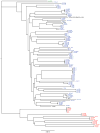Environmental reservoirs for exoS+ and exoU+ strains of Pseudomonas aeruginosa
- PMID: 29687624
- PMCID: PMC6108916
- DOI: 10.1111/1758-2229.12653
Environmental reservoirs for exoS+ and exoU+ strains of Pseudomonas aeruginosa
Abstract
Pseudomonas aeruginosa uses its type III secretion system to inject the effector proteins ExoS and ExoU into eukaryotic cells, which subverts these cells to the bacterium's advantage and contributes to severe infections. We studied the environmental reservoirs of exoS+ and exoU+ strains of P. aeruginosa by collecting water, soil, moist substrates and plant samples from environments in the Chicago region and neighbouring states. Whole-genome sequencing was used to determine the phylogeny and type III secretion system genotypes of 120 environmental isolates. No correlation existed between geographic separation of isolates and their genetic relatedness, which confirmed previous findings of both high genetic diversity within a single site and the widespread distribution of P. aeruginosa clonal complexes. After excluding clonal isolates cultured from the same samples, 74 exoS+ isolates and 16 exoU+ isolates remained. Of the exoS+ isolates, 41 (55%) were from natural environmental sites and 33 (45%) were from man-made sites. Of the exoU+ isolates, only 3 (19%) were from natural environmental sites and 13 (81%) were from man-made sites (p < 0.05). These findings suggest that man-made water systems may be a reservoir from which patients acquire exoU+ P. aeruginosa strains.
© 2018 Society for Applied Microbiology and John Wiley & Sons Ltd.
Figures

References
-
- Ayi B. Infections acquired via fresh water: from lakes to hot tubs. Microbiol Spectr. 2015:3. - PubMed
-
- Berthelot P, Attree I, Plesiat P, Chabert J, de Bentzmann S, Pozzetto B, Grattard F. Genotypic and phenotypic analysis of type III secretion system in a cohort of Pseudomonas aeruginosa bacteremia isolates: Evidence for a possible association between O serotypes and exo genes. J Infect Dis. 2003;188:512–518. - PubMed
-
- Bradbury RS, Roddam LF, Merritt A, Reid DW, Champion AC. Virulence gene distribution in clinical, nosocomial and environmental isolates of Pseudomonas aeruginosa. J Med Microbiol. 2010;59:881–890. - PubMed
-
- Choy MH, Stapleton F, Willcox MD, Zhu H. Comparison of virulence factors in Pseudomonas aeruginosa strains isolated from contact lens- and non-contact lens-related keratitis. J Med Microbiol. 2008;57:1539–15346. - PubMed
Publication types
MeSH terms
Substances
Grants and funding
LinkOut - more resources
Full Text Sources
Other Literature Sources

